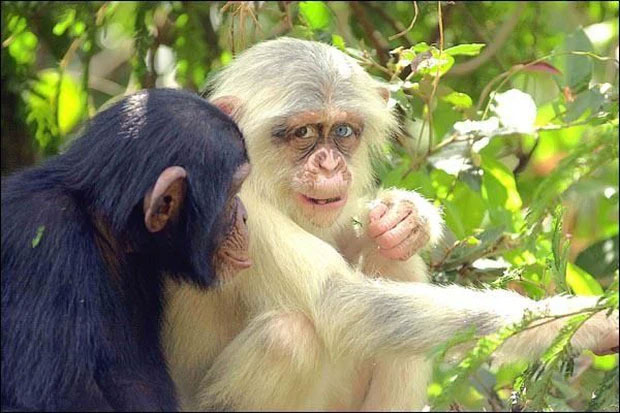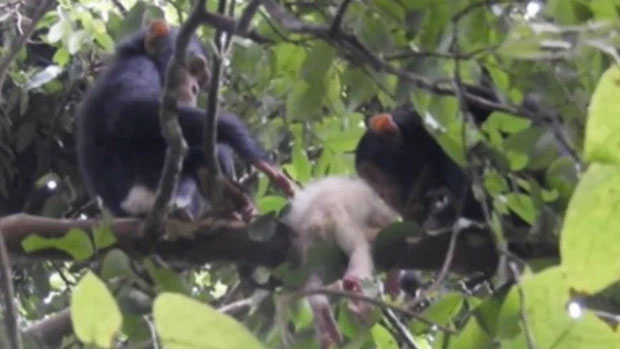A rare albino chimpanzee, just half a month old, was killed by its own kind, likely due to its distinct appearance.
On July 16, the American Journal of Primatology published a study by Ugandan scientists regarding the tragic death of an extremely rare albino chimpanzee in the wild. Just a few days after its discovery, the animal was killed by its own species.
The only previously reported albino chimpanzee was a Western chimpanzee (scientific name Pan troglodytes verus) named Pinkie. It was found as a newborn before being taken to the Tacugama Chimpanzee Sanctuary in Sierra Leone, a country in West Africa, where it lived until its sudden death at the age of 9.

Albino chimpanzee Pinkie.
Because Pinkie was brought to the sanctuary at just a few weeks old, scientists did not have the opportunity to observe its interactions with peers in the wild. Therefore, the discovery of another albino chimpanzee was of immense significance to researchers, though sadly its fate was all too brief.
The albino chimpanzee was discovered among a population of Eastern chimpanzees (scientific name: Pan troglodytes schweinfurthii) in the Budongo Forest Reserve, Uganda. At the time of its birth in 2018, the chimpanzee community there consisted of about 75 individuals.
In January 2018, a female chimpanzee named UP gave birth to a male albino infant. Based on its size and data about UP, the research team believes that when they encountered the infant chimpanzee on July 15 of the same year, it was only about 2 to 2.5 weeks old.
On that day, two adult chimpanzees accidentally came across UP and her special child. They roared as if confronting dangerous animals like snakes or bush pigs. Seeing the reaction of the two chimpanzees, UP screamed and climbed up a tree with her baby.
One of the two chimpanzees did not give up; it continued to howl and chase after them. In the following minutes, other chimpanzees joined in, exhibiting similar aggressive behavior. However, a few individuals chose to remain silent and cautiously observed UP and her baby. One calm chimpanzee approached UP and reached out to touch her.

Rare images of the albino infant chimpanzee.
UP climbed the tree with her albino baby clinging to her chest for a while before climbing down and hiding in dense bushes to avoid attention. That morning, the research team saw UP and her baby a few more times. They witnessed an adult chimpanzee accidentally come close to UP and her child at a short distance and roar fiercely.
Days later, on July 19, 2018, the albino chimpanzee’s short life came to an end.
That morning, assistant Bosco Chandia and researcher Maël Leroux, who were working at the field station and the University of Zurich, encountered a group of adult chimpanzees all howling. At the same time, the cries of the albino infant chimpanzee could be heard from the thick canopy, suggesting it was being attacked by its peers. Due to obstructed visibility, the research team could not see each individual involved in the conflict.
Shortly after, a male chimpanzee named HW emerged from the canopy and tightly held the white animal against his chest. The infant’s arm had been severed. Other chimpanzees, including UP, closely monitored HW’s every move. They all screamed as HW climbed higher, holding the infant and began biting its fingers, feet, and right ear. At this moment, UP had been driven away by the larger males.
Minutes later, an adult female took the albino chimpanzee from HW’s hands and began biting the body of the poor animal. After being bitten repeatedly on the head, the infant chimpanzee stopped moving and appeared to be dead.
Afterward, the body of the infant chimpanzee was placed on a branch. In the following hours, other chimpanzees approached the corpse, sniffing as if to examine it, occasionally grooming the remains of the unfortunate animal. Eventually, the chimpanzees left, and the research team collected the body for further study.
The autopsy results showed that the skin, fur, and eyes of the animal all lacked pigmentation, resulting in its entirely white appearance. The animal weighed about 2.1 kg and had suffered severe injuries, including deep wounds to the head and a fracture in the skull that exposed the brain tissue.
Regarding the reactions of the chimpanzees, the research team noted that they were completely different from other cases. Typically, chimpanzees tend to be curious when encountering an infant; they will touch and groom the infant as well as the mother. The most common emotion is excitement, sometimes bordering on excessive, but the reaction of the individuals towards the albino chimpanzee was quite unusual.
The way the chimpanzee group examined the albino infant after its death was also abnormal. It seemed they viewed the animal before them as a different species or at least as a “foreigner” from another land.
Due to the limited observation time, the research team could only speculate rather than confirm that the albino chimpanzee was killed because of its distinct appearance. Another reason might be that the chimpanzee group had a history of killing peers that were not albino. As for Pinkie, scientists also had little documentation of its interactions with peers in the wild. Therefore, it remains unclear whether the community’s reaction to an albino infant is considered typical or abnormal.


















































